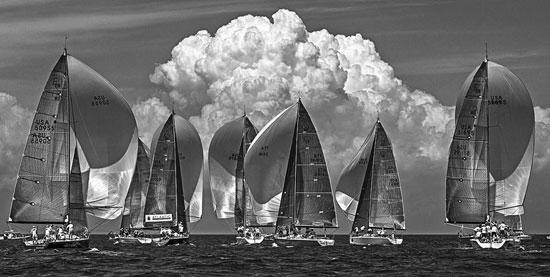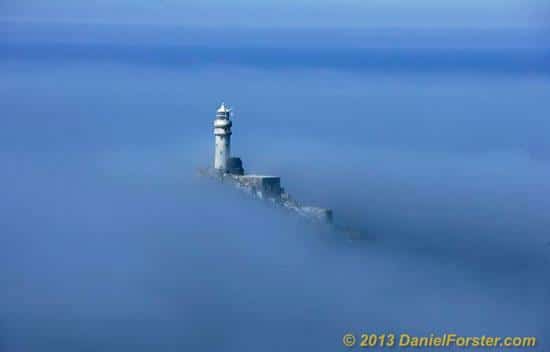
**
Tell us about this shot.**
I saw the cloud when I arrived on the race course and told the photo boat driver: “This will be a black and white picture. And, it will be a photo of a cloud with boats in it…”
I directed the driver, Cindy Delatto, to get the yachts centered under the cloud.
First there were only a few Farr 40s racing downwind under spinnaker, but I waited until 8 of the total 11 yachts where perfectly positioned, going for the leeward gate. To get the right distance from the fleet with the right lens was the important piece in the puzzle!
Some people told me: “I was out there and never saw the cloud.” It’s all about keeping a wide horizon and “looking around the yachts.” Then I worked on the cloud to get the billowing effect.
What are your favorite shooting conditions?
Ask me what conditions I don’t like: Perfect 12 knots of wind with blue sky: boring!
I like, love, clouds and waves on a swell, not easy to get, but worth waiting for. When I take guests along I make sure they don’t get seasick! We can’t take them back and miss a photo.
How do you protect your gear from all of these elements?
I have a waterproof HPRC box on wheels where I can fit my camera bodies and lenses, up to 600 mm. Then I have a waterproof backpack from Lowepro and a waterproof bag from a San Diego manufacturer. When you go onboard yachts you cannot always bring a box!
Have you ever had a gear catastrophe?
I had a six-year-old camera stop working in very humid conditions, before CANON sealed their bodies. Now I can keep taking photos (I hate when people use the word “shooting”) even in rainy conditions.
But I always bring a back-up, just like Wilhelm Tell, me being Swiss. But that’s another story 😉
What sort of editing do you do?
I have an assistant for the Rolex events and we make the selection together in Photo Mechanic. She then works in Lightroom and Photoshop.
When I do my own editing, like during the Rolex Farr 40 North American Championship, I use Photo Mechanic, Photoshop, and sometimes Aperture.
What camera do you use?
I have been using CANON cameras since 1972! I went through their whole professional lineup:
From the CANON FTb QL body, during the good or bad, old Kodachrome days, all the way to the CANON EOS-1D X I used during the 2012 Weymouth Olympic Games, plus the CANON 5D Mark III and the CANON EOS 6D. Some I own, some are given to me by CANON to test.
How did you get started in photography? What did you do for work before you became a photographer?
I am celebrating 40 years of Forster Photography. Started as an apprentice in a commercial photo studio in Berne, Switzerland and went to professional photographers school. We did big format photography in 8 x 10 inch format and processed the color film ourselves. Those were the days!
I then switched to 24 x 36 mm cameras when I started sport photography. The Swiss Yachting magazine sent me to Kiel Week, the oldest sailing week and still the biggest in the world. I wrote French and German articles and photographed in Kodachrome and Ilford.
The 1972 Sailing Olympic Games were held in Kiel, and I covered 11 Olympic Games since, the 1988 Winter Games included.
These events and the 11 America’s Cups I covered since 1977, the longest uninterrupted streak for a photographer, became my stepping stones in my career.
How does a Farr 40 event on the Vineyard differ from taking pictures at the Olympics?
In four words: There is no comparison.
In more words: Olympic class dinghies are very fast, everything happens quickly. During the Olympic Games they don’t let you close to the marks, so we need long lenses, very long lenses. When I was at the finish of the Men’s 470 class I used the CANON EOS-1D X with a 600 mm lens and an extender, making it a 840 mm lens!
I shot at 12 images per second to get the very unusual shot of the Australian crew celebration with a back flip!

During the Olympics there were six circles to cover and then 600 to 800 files to look through, scale them down to 50 selected photos, which then had to get edited in Photoshop and sent to magazines, websites, and agencies in different resolutions.
The Rolex Farr 40 North American Championship in Edgartown was slightly, very slightly different: 11 one-design yachts, two to three races a day. That is why I had time to edit the photos and then go further by working on them in Photoshop again, using different techniques to give them an unusual look. Especially the ones taken in the grey and rainy conditions.
What’s the coolest place sailing and photography has taken you?
This is like asking: Which of your children do you prefer ?
I have been privileged to travel to exquisite places, but my most special cruising trips were definitely sailing through the Beagle Channel around Cape Horn,
with the many fiords who lead to glaciers coming all the way down to the water and exploring the Galapagos where the species are different on each island.
I visited both places with Patrick de Barros’ yacht SELJM. We did publish a book with my text and photographs about the two voyages: “In the Wake of Charles Darwin”.
A close second and third are Tasmania, which I have been visiting during the last 12 Rolex Sydney Hobart Races and New Zealand, where I spent many happy days thanks to the America’s Cup racing there.
Next project: Rolex Fastnet Race.

What do you do in your free time?
I sail in Newport and whenever I don’t have to take photos during my travels, hike in Switzerland with my partner Kim and go fishing with my daughter Daphne.
Click here for previous installments of the Photo of the Month.









